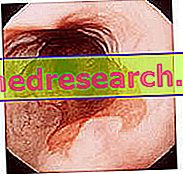Definition
An anaphylactic crisis, also called anaphylaxis, is a sudden, violent and exaggerated reaction of the body against a substance (antigen / allergen) normally harmless to healthy subjects. The severity of anaphylaxis is very high, so much so as to be potentially lethal.
Causes
Ideally, all foods, drugs and substances foreign to the body may be considered allergens and may generate anaphylaxis; however, some substances are considered more dangerous than others, and include: certain foods (eg nuts, peaches, crustaceans, peanuts, milk, eggs) and drugs (eg penicillin, muscle relaxants used in general anesthesia, NSAIDs), punctures of bees, wasps and hornets, latex. Rare, albeit possible, recorded cases of anaphylaxis due to excessive exercise.
Symptoms
The symptoms associated with anaphylaxis generally begin a few minutes after exposure to the allergen; among these, the most common are: anxiety, heart disease, constriction of the respiratory tract, diarrhea, difficulty breathing, abdominal pain, erythema, hypotension, swollen tongue, nausea, hives, itching, fainting, dizziness, vomiting.
Information on anaphylaxis - Drugs for the treatment of anaphylaxis are not intended to replace the direct relationship between health professional and patient. Always consult your doctor and / or specialist before taking anaphylaxis - drugs for the treatment of anaphylaxis.
drugs
Some cases of anaphylaxis are treated simply with antihistamines and corticosteroids, although in the event of severity hospitalization and medical observation of the patient are required. An adrenaline injection is often useful for slowing the progression of symptoms, especially in the event of a severe anaphylactic reaction.
Anaphylaxis should not be underestimated, since it can cause loss of consciousness or other serious complications: anaphylactic shock is, in fact, a medical emergency that can cause death, caused by a rapid obstruction of the respiratory tract.
In general, adrenaline reduces exaggerated allergic response, while antihistamines and corticosteroids can reduce airway inflammation, thereby improving the patient's respiratory capacity; again, to alleviate respiratory symptoms, the patient may be given a dose of albuterol or other beta-agonist drugs. Eventually, the patient undergoes a treatment with oxygen and cardiopulmonary resuscitation.
Anaphylaxis → respiratory obstruction → suffocation → lack of oxygenation to the brain → irreversible damage or death
Catecholamines :
- Adrenaline or epinephrine (eg Jext, Adrenal, Fastjekt): the drug is a powerful muscular vasodilator, useful for preventing airway obstruction in case of anaphylaxis; patients who are predisposed to it should always bring with them an adrenaline syringe for emergency self-injection. The effect of adrenaline is not lasting; the drug generates cold sweats and frozen extremities. It is recommended to administer the drug intramuscularly at the dosage of 0.3-0.5 ml in the adult and 0.01 ml / kg (max. 0.3 mg) in the child, immediately after the manifestation of the typical symptoms of anaphylaxis; repeat the administration every 5-15 minutes, depending on the severity of the condition. Administer the drug intravenously only when the anaphylaxis is very serious, since the drug could generate tachyarrhythmia: in this case, it is recommended to inject a dose of 2-10 mcg / min; only rarely are doses higher than 20 mcg / min required. In more severe cases, the drug is given intracardiacally (direct injection into the left ventricle: 0.3-0.5 mg) or endotracheal (1 mg).
Antihistamines:
- Promethazine (eg: Promet NAR, Farganesse, Fenazil): antihistamine drug. Parenterally, it is recommended to take the drug at a dose of 25 mg (intravenous or intramuscular injection). When necessary, repeat the administration after 2 hours. Oral therapy can be undertaken after the patient's recovery. Orally, it is recommended to take 25 mg of active; repeat the administration after 4 hours, if necessary. In the context of anaphylaxis, for relapse prevention, it is also possible to take the drug rectally (25 mg, to be repeated every 4 hours).
- Diphenhydramine (eg. Aliserin, Difeni C FN): anticholinergic and antihistamine drug. It is recommended to take the drug at a dose of 25-50 mg, intravenously.
- Ranitidine (eg. Zantac): the drug, belonging to the class of antihistamines anti H2, should be administered indicatively at the dose of 50 mg intravenously or 150 mg orally, to keep under control the symptoms that accompany anaphylaxis. Generally, it is given after the adrenaline injection.
β2 - agonists:
- Albuterol or salbutamol (eg Ventmax, Ventolin, Almeida, Naos): the drug, belonging to the class of β2 - agonists, is indicated to treat bronchospasm associated with anaphylaxis. The drug is administered nasally, applying 2 sprays per nostril every 6-8 hours, or as needed. Consult your doctor.
Corticosteroids : steroid medications are essential for reducing inflammation and minimizing secondary symptoms related to anaphylaxis
- Prednisone ( eg. Deltacortene, Lodotra ): in the case of anaphylaxis, take 50 mg of active per os, possibly fractionated in several doses during the 24 hours.
- Methylprednisolone (eg Advantan, Methylpre, Depo-medrol, Medrol, Urbason): in the context of anaphylaxis, the indicative dose of this drug is 125 mg intravenously.


